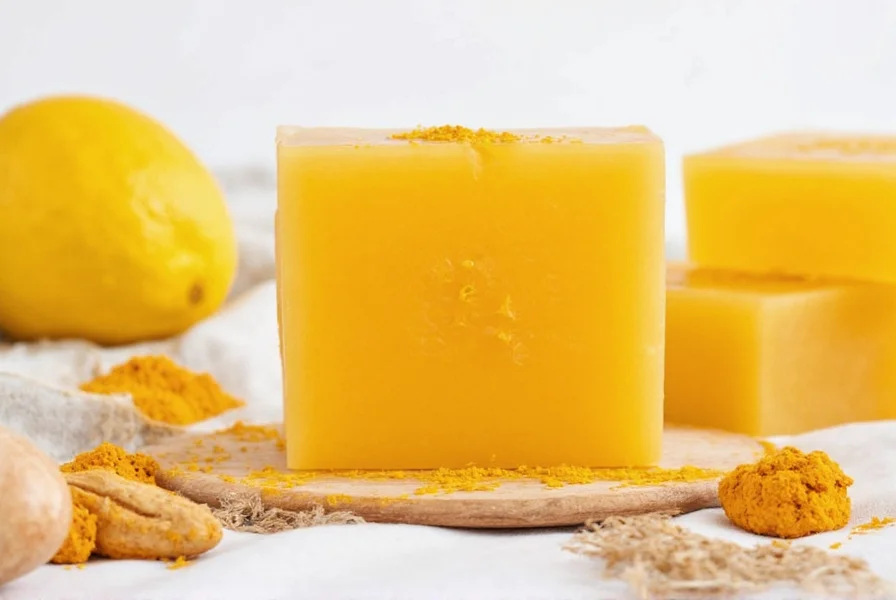Making turmeric soap at home offers a natural solution for glowing, healthy skin. This golden-hued soap harnesses curcumin, turmeric's active compound, which has been scientifically proven to reduce inflammation and fight free radicals. When properly formulated, homemade turmeric soap provides gentle exfoliation while addressing common skin concerns like acne, hyperpigmentation, and uneven texture.
Why Turmeric Benefits Your Skin
Turmeric isn't just a kitchen staple—it's a skincare powerhouse. Research published in Phytotherapy Research confirms that curcumin effectively reduces inflammatory markers in skin cells. When incorporated into soap, turmeric:
- Naturally brightens dull complexion by inhibiting melanin production
- Reduces redness and inflammation associated with acne
- Provides antioxidant protection against environmental damage
- Supports wound healing and reduces scarring
Unlike commercial products that may contain synthetic additives, homemade turmeric soap delivers these benefits without harsh chemicals.
Essential Ingredients and Equipment
Before starting your turmeric soap making process for beginners, gather these items:
| Category | Items Needed | Why It's Important |
|---|---|---|
| Fats/Oils | Olive oil (500g), Coconut oil (200g), Shea butter (100g) | Creates a balanced soap that's moisturizing without being greasy |
| Alkali | Sodium hydroxide (lye) - 135g | Necessary for saponification (turning oils into soap) |
| Liquid | Distilled water - 320g | Dissolves lye safely and activates saponification |
| Additives | Turmeric powder (2 tbsp), Essential oils (optional) | Provides color, benefits, and fragrance |
| Safety Gear | Gloves, goggles, long sleeves, well-ventilated area | Protects from lye exposure during natural turmeric soap recipe preparation |

Safety First: Working with Lye
Lye (sodium hydroxide) is essential for cold process soap making but requires careful handling. Always:
- Add lye to water—not water to lye—to prevent dangerous eruptions
- Work in a well-ventilated area away from children and pets
- Wear chemical-resistant gloves and eye protection
- Use heat-resistant containers (stainless steel or heavy-duty plastic)
- Keep vinegar nearby to neutralize any spills
Remember that properly made soap contains no residual lye after saponification completes—typically within 24-48 hours.
Step-by-Step Turmeric Soap Making Process
Step 1: Prepare Your Workspace
Cover your work area with newspaper or plastic sheeting. Arrange all ingredients and equipment within easy reach. Put on your safety gear before handling lye.
Step 2: Create the Lye Solution
Slowly add 135g lye to 320g distilled water while stirring gently. Never reverse this order. The mixture will heat to 200°F+ and release fumes—step away and allow it to cool in a safe location. This takes 1-2 hours.
Step 3: Prepare Oils
Melt 200g coconut oil and 100g shea butter over low heat. Add 500g olive oil once melted. Cool the oil mixture to 100-110°F.
Step 4: Combine and Mix
When both lye solution and oils reach 100-110°F, slowly pour lye into oils while blending with a stick blender. Mix to "trace"—when the mixture thickens to cake batter consistency.
Step 5: Add Turmeric
Stir in 2 tablespoons turmeric powder and optional essential oils. For a marbled effect, reserve some plain soap batter before adding turmeric.
Step 6: Mold and Insulate
Pour into silicone or wooden molds. Cover with parchment paper, then insulate with towels for 24 hours to complete saponification.
Step 7: Unmold and Cut
After 24-48 hours, unmold and cut into bars. The soap will still be soft but firm enough to hold its shape.
Step 8: Cure Properly
Place bars on a drying rack in a cool, dark, well-ventilated area. Turn daily for even drying. Proper curing takes 4-6 weeks, during which water evaporates, creating a harder, longer-lasting bar.
Turmeric Soap Troubleshooting Guide
Even experienced soap makers encounter issues. Here's how to solve common problems when making turmeric soap:
- Orange stains: Turmeric can temporarily stain skin and surfaces. Wear gloves and use dedicated equipment. Stains wash off skin within hours.
- Accelerated trace: If soap thickens too quickly, work faster or reduce essential oils. Turmeric can speed trace slightly.
- Discoloration: Fresh turmeric may turn brown. Use high-quality powder and avoid overheating.
- Soft soap: Extend cure time or adjust oil percentages. Too much olive oil creates softer bars.
- White ash: Normal during curing. Wipe with alcohol spray if appearance matters.
Using Your Homemade Turmeric Soap
For best results with your natural turmeric soap for glowing skin:
- Use within 12 months for maximum potency
- Store unused bars in a cool, dark place with airflow
- Lather on damp skin for 30 seconds before rinsing
- Follow with moisturizer for dry skin types
- Use daily for acne-prone skin or 2-3 times weekly for maintenance
Most users notice improved skin tone and texture within 4-6 weeks of regular use. Turmeric soap works particularly well as a natural turmeric soap for acne treatment due to its antibacterial properties.
Final Thoughts on Homemade Turmeric Soap
Creating your own turmeric soap allows complete control over ingredients while delivering skin benefits commercial products often lack. The easy turmeric soap making process for beginners yields a product rich in curcumin without synthetic additives or preservatives. With proper safety precautions and curing time, your homemade soap will provide gentle cleansing with significant skincare benefits. Remember that natural products work gradually—consistent use over several weeks delivers the best results for skin brightening and inflammation reduction.










 浙公网安备
33010002000092号
浙公网安备
33010002000092号 浙B2-20120091-4
浙B2-20120091-4